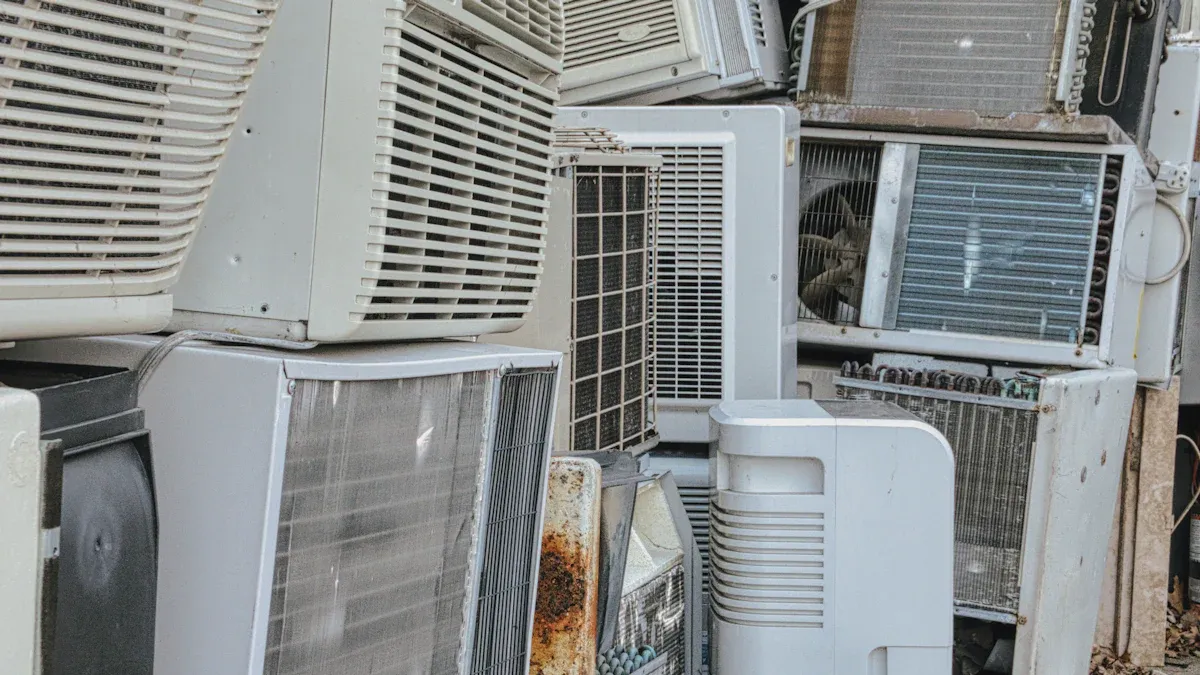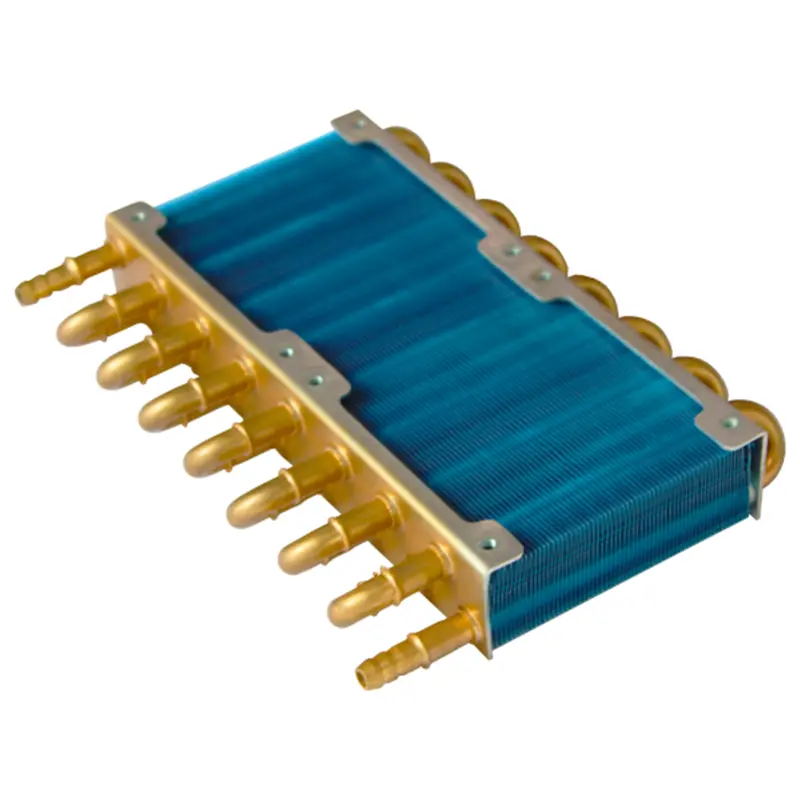Mini Fridge Heat Exchangers: Efficient Cooling in Compact Spaces

Mini fridge heat exchangers play a vital role in compact cooling systems by efficiently transferring heat to maintain low temperatures. These systems are essential for conserving energy, especially in small spaces where every watt counts. Ningbo Senjun New Materials Co., Ltd. leads the way in advancing technologies like wire tube condensers and copper fin heat exchangers, enabling higher cooling performance and compliance with global energy standards.
Key Takeaways
- Mini fridge heat exchangers cool by moving heat efficiently. This saves energy and lowers electricity bills.
- Copper fin heat exchangers work better because they conduct heat well. They are small, strong, and great for tight spaces.
- When picking a mini fridge, check the heat exchanger material, how well it cools, how loud it is, and its energy use.
How Mini Fridge Heat Exchangers Work

The Basics of Heat Exchange
Heat exchange is the cornerstone of refrigeration systems, including mini fridges. It operates on the principles of thermodynamics, specifically the vapor compression cycle. This cycle involves four key stages: compression, condensation, expansion, and evaporation.
- Compression: The compressor increases the pressure and temperature of the refrigerant vapor, initiating the cooling process.
- Condensation: The high-pressure vapor releases heat in the condenser, transforming into a liquid.
- Expansion: The liquid refrigerant passes through an expansion valve, reducing its pressure and temperature.
- Evaporation: The refrigerant absorbs heat in the evaporator, cooling the surrounding space.
This cycle repeats continuously, ensuring consistent cooling. Mini fridge systems often use refrigerants like R134a, which offer high heat transfer rates and are ideal for compact designs.
Studies show that mini-channel condensers outperform conventional designs, achieving higher exergy efficiency and lower energy loss. These advancements highlight the importance of optimizing heat exchange mechanisms in compact cooling systems.
Components of a Mini Fridge Heat Exchanger
A mini fridge heat exchanger consists of several critical components that work together to transfer heat efficiently:
- Compressor: Powers the refrigeration cycle by compressing the refrigerant.
- Condenser: Releases heat from the refrigerant, often using wire tube or copper fin designs.
- Expansion Valve: Reduces the refrigerant's pressure and temperature.
- Evaporator: Absorbs heat to cool the fridge's interior.
The design and materials of these components significantly impact performance. For instance, copper fin heat exchangers enhance heat transfer due to copper's high thermal conductivity.
| Component | Function | Material Used |
|---|---|---|
| Compressor | Compresses refrigerant vapor | Steel |
| Condenser | Releases heat | Copper or Aluminum |
| Expansion Valve | Reduces pressure and temperature | Brass |
| Evaporator | Absorbs heat | Aluminum |
These components are meticulously engineered to ensure durability and efficiency, making mini fridges reliable for various applications.
The Role of Copper Fin Heat Exchangers in Mini Fridges
Copper fin heat exchangers play a pivotal role in mini fridge systems. Their design maximizes surface area, allowing for efficient heat transfer. Copper's thermal conductivity ensures rapid cooling, which is essential for compact refrigeration systems.
- Efficiency: Copper fin heat exchangers achieve higher heat transfer rates compared to other materials.
- Compact Design: Their geometry supports miniaturization without compromising performance.
- Durability: Copper resists corrosion, ensuring long-term reliability.
Recent studies reveal that refrigerators equipped with copper fin heat exchangers reduce condenser length by up to 33% while maintaining superior heat transfer coefficients. This innovation not only saves space but also enhances energy efficiency.
Experimental data confirms that copper fin designs outperform conventional systems, recovering up to 315.5% more heat energy. These findings underscore the effectiveness of copper fin heat exchangers in modern refrigeration technology.
Ningbo Senjun New Materials Co., Ltd. specializes in manufacturing copper fin heat exchangers for mini fridges, leveraging advanced engineering to deliver high-performance cooling solutions. Their products exemplify the synergy between compact design and energy efficiency, setting industry benchmarks.
Benefits of Mini Fridge Heat Exchangers
Energy Efficiency and Cost Savings
When I think about mini fridge heat exchangers, their energy efficiency stands out as a key benefit. These systems optimize the refrigeration cycle to minimize energy consumption. By using advanced materials like copper, they enhance heat transfer and reduce the workload on the compressor. This translates into lower electricity bills for users.
For example, a Copper Fin Heat Exchanger improves thermal conductivity, allowing the refrigerant to cool faster. This efficiency reduces the time the compressor needs to operate, saving energy. Over time, these savings add up, making mini fridges an economical choice for homes, offices, and even medical facilities.
Tip: Choosing a mini fridge with a Copper Fin Heat Exchanger can significantly lower your energy costs while maintaining consistent cooling performance.
Compact Design for Versatile Applications
Mini fridge heat exchangers are designed with space efficiency in mind. Their compact size makes them ideal for tight spaces, such as dorm rooms, small apartments, and RVs. I’ve seen these fridges used in a variety of settings, from wine cabinets to medical ultra-low temperature refrigerators.
The Copper Fin Heat Exchanger plays a crucial role in this compact design. Its geometry allows manufacturers to reduce the size of the condenser without sacrificing performance. This innovation enables mini fridges to fit seamlessly into spaces where traditional refrigerators would be impractical.
- Applications:
- Dorm rooms
- Office break rooms
- Recreational vehicles (RVs)
- Medical storage
This versatility makes mini fridges equipped with advanced heat exchangers a practical solution for diverse needs.
Quiet Operation and Durability
One of the most appealing features of mini fridge heat exchangers is their quiet operation. I’ve noticed that these systems produce minimal noise, making them suitable for bedrooms and study areas. The Copper Fin Heat Exchanger contributes to this by efficiently dissipating heat, reducing the strain on the compressor and lowering noise levels.
Durability is another advantage. Copper’s resistance to corrosion ensures that the heat exchanger remains functional for years. This reliability is especially important in applications like medical refrigerators, where consistent performance is critical.
Note: Investing in a mini fridge with a Copper Fin Heat Exchanger ensures long-term durability and quiet operation, making it a smart choice for both personal and professional use.
Choosing the Right Mini Fridge with a Heat Exchanger
Key Features to Consider
When selecting a mini fridge with a heat exchanger, I always focus on the features that directly impact performance and usability. Here are the key aspects I recommend evaluating:
- Heat Exchanger Material: Copper fin heat exchangers are my top choice due to their superior thermal conductivity and durability.
- Cooling Efficiency: Look for models with advanced compressors and optimized refrigerants like R134a for consistent cooling.
- Noise Levels: A quiet operation is essential, especially for bedrooms or offices.
- Build Quality: High-quality materials ensure long-term reliability and resistance to wear.
Tip: Always check the product specifications for details about the heat exchanger and compressor technology. This ensures you’re investing in a high-performance appliance.
Matching Size and Capacity to Your Needs
Choosing the right size and capacity is crucial. I always start by assessing the available space and the intended use.
- Compact Models: Ideal for dorm rooms, offices, or RVs. These fridges save space without compromising functionality.
- Larger Mini Fridges: Perfect for storing beverages, medical supplies, or food in small apartments or shared spaces.
| Use Case | Recommended Capacity |
|---|---|
| Dorm Room | 1.7–3.2 cubic feet |
| Office Break Room | 3.2–4.5 cubic feet |
| Medical Storage | 4.5+ cubic feet |
Note: Measure your space carefully before purchasing to avoid fitting issues.
Environmental Impact and Energy Ratings
I always prioritize energy-efficient models with minimal environmental impact. Look for fridges with high energy ratings and eco-friendly refrigerants.
- Energy Star Certification: Indicates compliance with energy efficiency standards.
- Eco-Friendly Refrigerants: Options like R600a reduce greenhouse gas emissions.
Reminder: Ningbo Senjun New Materials Co., Ltd. offers innovative heat exchanger solutions that align with global sustainability goals. Their products combine efficiency with environmental responsibility.
Mini fridge heat exchangers deliver efficient cooling by optimizing heat transfer mechanisms. Their compact design and energy-saving features make them indispensable for small spaces. I recommend evaluating material quality, cooling efficiency, and energy ratings when choosing a mini fridge. Brands like Ningbo Senjun New Materials Co., Ltd. offer reliable solutions that combine performance with sustainability.
FAQ
What makes copper fin heat exchangers better than other materials?
Copper fin heat exchangers excel due to their superior thermal conductivity, compact design, and corrosion resistance. These features ensure efficient cooling and long-term durability.
Can mini fridge heat exchangers work in extreme environments?
Yes, they can. Advanced designs, like those from Ningbo Senjun New Materials Co., Ltd., maintain performance in challenging conditions, including medical ultra-low temperature refrigerators and ice makers.
How do I maintain a mini fridge heat exchanger for optimal performance?
Regularly clean the condenser coils and ensure proper ventilation around the fridge. This prevents dust buildup and maintains efficient heat transfer.


















